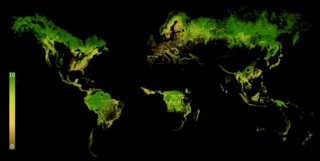Related Research Articles

At 475,440 km2 (183,570 sq mi), Cameroon is the world's 53rd largest country. It is slightly larger than the nation of Sweden and the US state of California. It is comparable in size to Papua New Guinea. Cameroon's landmass is 472,710 km2 (182,510 sq mi), with 2,730 km2 (1,050 sq mi) of water.
The environment of South Korea is the natural environment of South Korea, which occupies the southern half of the Korean peninsula. Environment - current issues: air pollution in large cities; water pollution from the discharge of sewage and industrial effluents; acid rain; drift net fishing.

Environmental issues in Mali include desertification, deforestation, soil erosion, drought, and inadequate supplies of potable water. Deforestation is an especially serious and growing problem. According to the Ministry of the Environment, Mali’s population consumes 6 million tons of wood per year for timber and fuel. To meet this demand, 4,000 square kilometers of tree cover are lost annually, virtually ensuring destruction of the country’s savanna woodlands.
Major environmental issues in Bolivia include managing its forests, preserving the country's levels of biodiversity, maintaining ecologically important protected areas, coping with the effects of climate change, and dealing with the environmental consequences of agriculture, mining, oil and gas development, and transportation infrastructure. Bolivia’s history of slash-and-burn agriculture, overgrazing, and industrial pollution has caused significant concern among environmentalists. Soil erosion, made worse by seasonal flooding, and contaminated water supplies are Bolivia’s most pressing environmental problems. The National Service for Protected Areas, established in 1998, currently manages 21 protected areas.

Environmental issues in Venezuela include natural factors such as earthquakes, floods, rockslides, mudslides, and periodic droughts.

Environmental issues in Kenya include deforestation, soil erosion, desertification, water shortage and degraded water quality, flooding, poaching, and domestic and industrial pollution.
The major environmental issues in Kyrgyzstan, are summarized in the 2007 Concept of Ecological Security of Kyrgyz Republic and discussed in other environmental and environmental policy documents such as National Environmental Action Plan (1995), Country Development Strategy for 2009–2011, Strategy on Biological Diversity (2002), 2nd Environmental Performance Review of Kyrgyzstan (2008), etc.
Environmental issues in Paraguay include deforestation.

The forestry sector in Argentina has great potential. The geography of the country extends from north to south, encompassing 4,000 kilometres (2,500 mi). Its variety of climates, land quality, and reliable precipitation allow for the cultivation of different tree species at high growth rates. The climate varies and most areas are quite temperate. The country also enjoys short harvest periods for the most important species. This has allowed the industry to become more competitive and continue its high growth rates.

Environmental issues in Malaysia
Like other island nations, Antigua and Barbuda faces unique environmental issues created by its proximity to the ocean, and small size. These include pressures on water resources, natural ecosystems, and deforestation more generally.
The Environment of Argentina is characterised by high biodiversity.
The Environment of Ecuador contains almost 20,000 species of plants, 1,500 species of birds, 341 species of mammals and more than 840 species of reptiles and amphibians. It includes World Heritage Sites like the Galápagos Islands, and magnificent parks such as the Yasuni National Park.
The principal environmental issues in Peru are water pollution, soil erosion, pollution and deforestation. Although these issues are problematic and equally destructive, the Peruvian Environmental ministry has been developing regulation and laws to decrease the amount of pollution created in major cities and have been making policies in order to decrease the present deforestation rate in Peru.
Environment of the Netherlands

Many of the issues have been attributed to policies that were made during the early Soviet Union, at a time when many officials felt that pollution control was an unnecessary hindrance to economic development and industrialization, and, even though numerous attempts were made by the Soviet government to alleviate the situation in the 1970s and 1980s, the problems were not completely solved. By the 1990s, 40% of Russia's territory began demonstrating symptoms of significant ecological stress, largely due to a diverse number of environmental issues, including deforestation, energy irresponsibility, pollution, and nuclear waste. According to Russia's Ministry of Natural Resources and Environment, Russia is currently warming 2.5 times faster than the rest of the globe.
There are a number of known environmental issues in the post-communist country of Albania. Issues include air and water pollution, poor waste management infrastructure and deforestation. The Albanian environmental movement includes around 40 active non-government organisations.
Environmental issues in Singapore include air, water pollution, and deforestation. The government established the Singapore Green Plan in 1992 to help with environmental issues.
Senegal's environmental issues are varied. According to the CIA world factbook pressing problems exist with: diminishing wildlife populations which are threatened by poaching, deforestation, overgrazing, soil erosion, desertification, and overfishing.

The Forest Landscape Integrity Index (FLII) is an annual global index of forest condition measured by degree of anthropogenic modification. Created by a team of 48 scientists, the FLII, in its measurement of 300m pixels of forest across the globe, finds that ~17.4 million km2 of forest has high landscape-level integrity, compared to ~14.6 million with medium integrity (6-9.6) and ~12.2 million km2 with low integrity (0-6).
References
- ↑ "Angola Forest Information and Data". Mongabay. Retrieved 25 March 2020.
- ↑ Grantham, H. S.; Duncan, A.; Evans, T. D.; Jones, K. R.; Beyer, H. L.; Schuster, R.; Walston, J.; Ray, J. C.; Robinson, J. G.; Callow, M.; Clements, T.; Costa, H. M.; DeGemmis, A.; Elsen, P. R.; Ervin, J.; Franco, P.; Goldman, E.; Goetz, S.; Hansen, A.; Hofsvang, E.; Jantz, P.; Jupiter, S.; Kang, A.; Langhammer, P.; Laurance, W. F.; Lieberman, S.; Linkie, M.; Malhi, Y.; Maxwell, S.; Mendez, M.; Mittermeier, R.; Murray, N. J.; Possingham, H.; Radachowsky, J.; Saatchi, S.; Samper, C.; Silverman, J.; Shapiro, A.; Strassburg, B.; Stevens, T.; Stokes, E.; Taylor, R.; Tear, T.; Tizard, R.; Venter, O.; Visconti, P.; Wang, S.; Watson, J. E. M. (2020). "Anthropogenic modification of forests means only 40% of remaining forests have high ecosystem integrity - Supplementary Material". Nature Communications. 11 (1): 5978. doi:10.1038/s41467-020-19493-3. ISSN 2041-1723. PMC 7723057 . PMID 33293507.
- ↑ "Angola with 60 million hectares of forests". Agencia Angola Press. 14 February 2017. Retrieved 25 March 2020.
